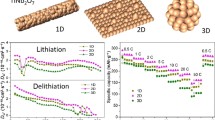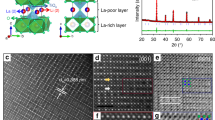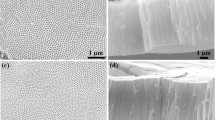Abstract
PX-phase PbTiO3 (PT) nanowires with open channels running along the length direction have been investigated as an anode material for lithium ion batteries. This material shows a stabilized reversible specific capacity of about 410 mAh·g–1 up to 200 cycles with a charge/discharge voltage plateau of around 0.3–0.65 V. In addition, it exhibits superior high-rate performance, with 90% and 77% capacity retention observed at 1 and 2 A·g–1, respectively. At a very high current rate of 10 A·g–1, a specific capacity of over 170 mAh·g–1 is retained up to 100 cycles, significantly outperforming the rate capability reported for Pb and Pb oxides. The results of X-ray photoelectron spectroscopy (XPS) and transmission electron microscopy (TEM) analyses along with the cyclic voltammogram results reveal that the PX-phase PT nanowires undergo irreversible structural amorphization and reduction reactions during the initial cycle, which allow them to transform into a composite structure composed of 2–5 nm Pb nanoparticles uniformly dispersed in the 1D amorphous Li2O·TiO2·LiTiO2 matrix. In this composite structure, the presence of abundant amounts of Ti3+ in both the charged and discharged states enhances the electrical conductance of the system, whereas the presence of ultrafine Pb nanoparticles imparts high reversible capacity. The structurally stable TiO2-based amorphous matrix can also considerably buffer the volume variation during the charge/discharge process, thereby facilitating extremely stable cycling performance. This compound combines the high specific capacity of Pb-based materials and the good rate capability of Ti3+-based wiring. Our results might furnish a possible route for achieving superior cycling and rate performance and contribute towards the search for next-generation anode materials.

Similar content being viewed by others
References
Armand, M.; Tarascon, J.-M. Building better batteries. Nature 2008, 451, 652–657.
Park, D.-Y.; Sun, Y.-K.; Myung, S.-T. Carbothermal synthesis of molybdenum(IV) oxide as a high rate anode for rechargeable lithium batteries. J. Power Sources 2015, 280, 1–4.
Liang, J. W.; Li, X. N.; Zhu, Y. C.; Guo, C.; Qian, Y. T. Hydrothermal synthesis of nano-silicon from a silica sol and its use in lithium ion batteries. Nano Res. 2015, 8, 1497–1504.
Im, H. S.; Cho, Y. J.; Lim, Y. R.; Jung, C. S.; Jang, D. M.; Park, J.; Shojaei, F.; Kang, H. S. Phase evolution of tin nanocrystals in lithium ion batteries. ACS Nano 2013, 7, 11103–11111.
Chen, M. H.; Liu, J. L.; Chao, D. L.; Wang, J.; Yin, J. H.; Lin, J. Y.; Fan, H. J.; Shen, Z. X. Porous a-Fe2O3 nanorods supported on carbon nanotubes-graphene foam as superior anode for lithium ion batteries. Nano Energy 2014, 9, 364–372.
Deng, D.; Kim, M. G.; Lee, J. Y.; Cho, J. Green energy storage materials: Nanostructured TiO2 and Sn-based anodes for lithium-ion batteries. Energy Environ. Sci. 2009, 2, 818–837.
Plylahan, N.; Letiche, M.; Samy Barr, M. K.; Ellis, B.; Maria, S.; Phan, T. N. T.; Bloch, E.; Knauth, P.; Djenizian, T. High energy and power density TiO2 nanotube electrodes for single and complete lithium-ion batteries. J. Power Sources 2015, 273, 1182–1188.
Su, D. W.; Dou, S. X.; Wang, G. X. Mesocrystal Co3O4 nanoplatelets as high capacity anode materials for Li-ion batteries. Nano Res. 2014, 7, 794–803.
Jiang, J.; Li, Y. Y.; Liu, J. P.; Huang, X. T.; Yuan, C. Z.; Lou, X. W. Recent advances in metal oxide-based electrode architecture design for electrochemical energy storage. Adv. Mater. 2012, 24, 5166–5180.
Li, H.; Wang, Z. X.; Chen, L. Q. Huang, X. J. Research on advanced materials for Li-ion batteries. Adv. Mater. 2009, 21, 4593–4607.
Konstantinov, K.; Ng, S. H.; Wang, J. Z.; Wang, G. X.; Wexler, D.; Liu, H. K. Nanostructured PbO materials obtained in situ by spray solution technique for Li-ion batteries. J. Power Sources 2006, 159, 241–244.
Pan, Q. M.; Wang, Z. J.; Liu, J.; Yin, G. P.; Gu, M. PbO@C core–shell nanocomposites as an anode material of lithiumion batteries. Electrochem. Commun. 2009, 11, 917–920.
Martos, M.; Morales, J.; Sánchez, L. Lead-based systems as suitable anode materials for Li-ion batteries. Electrochim. Acta 2003, 48, 615–621.
Wang, J.; Schenk, K.; Carvalho, A.; Wylie-van Eerd, B.; Trodahl, J.; Sandu, C. S.; Bonin, M. Gregora, I.; He, Z. B.; Yamada, T. et al. Structure determination and compositional modification of body-centered tetragonal PX-phase lead titanate. Chem. Mater. 2011, 23, 2529–2535.
Yu, X. Y.; Wu, H. B.; Yu, L.; Ma, F. X.; Lou, X. W. Rutile TiO2 submicroboxes with superior lithium storage properties. Angew. Chem., Int. Ed. 2015, 54, 4001–4004.
Tian, M.; Wang, W.; Liu, Y.; Jungjohann, K. L.; Thomas Harris, C.; Lee, Y.-C.; Yang, R. G. A three-dimensional carbon nano-network for high performance lithium ion batteries. Nano Energy 2015, 11, 500–509.
Ji, L. W.; Lin, Z.; Alcoutlabi, M.; Zhang, X. W. Recent developments in nanostructured anode materials for rechargeable lithium-ion batteries. Energy Environ. Sci. 2011, 4, 2682–2699.
Henningsson, A.; Rensmo, H.; Sandell, A.; Siegbahn, H.; Södergren, S.; Lindström, H.; Hagfeldt, A. Electronic structure of electrochemically Li-inserted TiO2 studied with synchrotron radiation electron spectroscopies. J. Chem. Phys. 2003, 118, 5607–5612.
Li, X. H.; He, Y. B.; Miao, C.; Qin, X. Y.; Lv, W.; Du, H. D.; Li, B. H.; Yang, Q. H.; Kang, F. Y. Carbon coated porous tin peroxide/carbon composite electrode for lithium-ion batteries with excellent electrochemical properties. Carbon 2015, 81, 739–747.
Ohzuku, T.; Shimamoto, T.; Hirai, T. Lead oxides as cathode for lithium non-aqueous cells. Electrochim. Acta 1981, 26, 751–754.
Kim, K.-T.; Yu, C.-Y.; Kim, S.-J.; Sun, Y.-K.; Myung, S.-T. Carbon-coated anatase titania as a high rate anode for lithium batteries. J. Power Sources 2015, 281, 362–369.
Myung, S. T.; Takahashi, N.; Komaba, S.; Yoon, C. S.; Sun, Y. K.; Amine, K.; Yashiro, H. Nanostructured TiO2 and its application in lithium-ion storage. Adv. Funct. Mater. 2011, 21, 3231–3241.
Liu, S. H.; Jia, H. P.; Han, L.; Wang, J. L.; Gao, P. F.; Xu, D. D.; Yang, J.; Che, S. N. Nanosheet-constructed porous TiO2–B for advanced lithium ion batteries. Adv. Mater. 2012, 24, 3201–3204.
Menéndez, R.; Alvarez, P.; Botas, C.; Nacimiento, F.; Alcántara, R.; Tirado, J. L.; Ortiz, G. F. Self-organized amorphous titania nanotubes with deposited graphene film like a new heterostructured electrode for lithium ion batteries. J. Power Sources 2014, 248, 886–893.
Hegde, R. I.; Sainkar, S. R.; Badrinarayanan, S.; Sinha, A. P. B. A study of dilute tin alloys by X-ray photoelectron spectroscopy. J. Electron. Spectrosc. Relat. Phenom. 1981, 24, 19–25.
Dementjev, A. P.; Ivanova, O. P.; Vasilyev, L. A.; Naumkin, A. V.; Nemirovsky, D. M.; Shalaev, D. Y. Altered layer as sensitive initial chemical state indicator. J. Vac. Sci. Technol. A 1994, 12, 423–425.
Bach, S.; Pereira-Ramos, J. P.; Willman, P. Investigation of lithium diffusion in nano-sized rutile TiO2 by impedance spectroscopy. Electrochim. Acta 2010, 55, 4952–4959.
Gao, Q.; Gu, M.; Nie, A. M.; Mashayek, F.; Wang, C. M.; Odegard, G. M.; Shahbazian-Yassar, R. Direct evidence of lithium-induced atomic ordering in amorphous TiO2 nanotubes. Chem. Mater. 2014, 26, 1660–1669.
Chen, Z. X.; Cao, Y. L.; Qian, J. F.; Ai, X. P.; Yang, H. X. Pb-sandwiched nanoparticles as anode material for lithiumion batteries. J Solid State Electr. 2012, 16, 291–295.
Shu, J.; Ma, R.; Shao, L. Y.; Shui, M.; Wang, D. J.; Wu, K. G.; Long, N. B.; Ren, Y. L. Hydrothermal fabrication of lead hydroxide chloride as a novel anode material for lithiumion batteries. Electrochim. Acta 2013, 102, 381–387.
Wang, D. J.; Wu, K. Q.; Shao, L. Y.; Shui, M.; Ma, R.; Lin, X. T.; Long, N. B.; Ren, Y. L.; Shu, J. Facile fabrication of Pb(NO3)2/C as advanced anode material and its lithium storage mechanism. Electrochim. Acta 2014, 120, 110–121.
Wood, S. M.; Powell, E. J.; Heller, A.; Mullins, C. B. Lithiation and delithiation of lead sulfide (PbS). J. Electrochem. Soc. 2015, 162, A1182–A1185.
Author information
Authors and Affiliations
Corresponding author
Rights and permissions
About this article
Cite this article
Shi, Z., Wang, J., Wang, W. et al. Remarkable anodic performance of lead titanate 1D nanostructures via in-situ irreversible formation of abundant Ti3+ as conduction pathways. Nano Res. 9, 353–362 (2016). https://doi.org/10.1007/s12274-015-0914-8
Received:
Revised:
Accepted:
Published:
Issue Date:
DOI: https://doi.org/10.1007/s12274-015-0914-8




